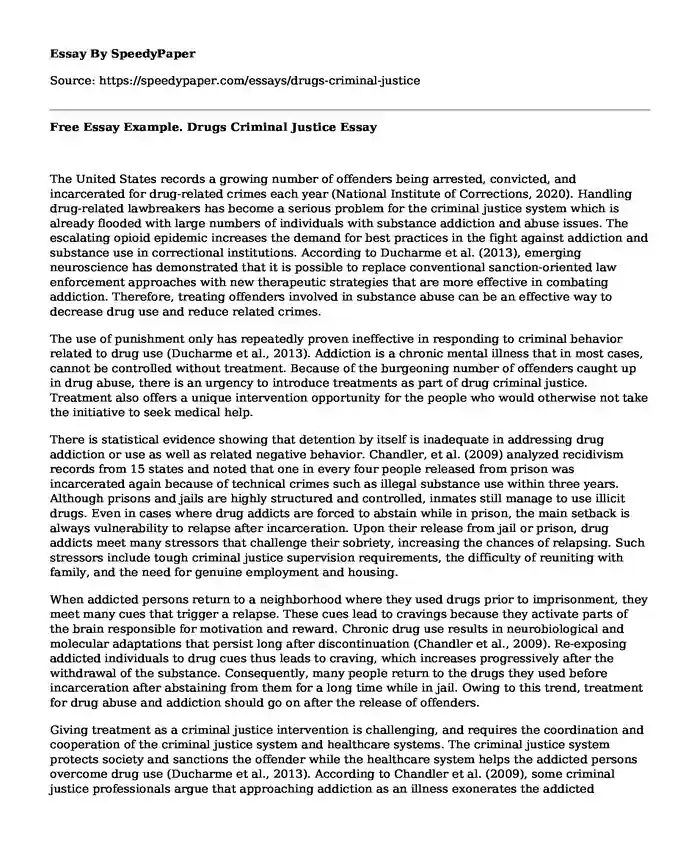
| Type of paper: | Research paper |
| Categories: | Penal system Criminal justice Community health Drug abuse |
| Pages: | 3 |
| Wordcount: | 680 words |
The United States records a growing number of offenders being arrested, convicted, and incarcerated for drug-related crimes each year (National Institute of Corrections, 2020). Handling drug-related lawbreakers has become a serious problem for the criminal justice system which is already flooded with large numbers of individuals with substance addiction and abuse issues. The escalating opioid epidemic increases the demand for best practices in the fight against addiction and substance use in correctional institutions. According to Ducharme et al. (2013), emerging neuroscience has demonstrated that it is possible to replace conventional sanction-oriented law enforcement approaches with new therapeutic strategies that are more effective in combating addiction. Therefore, treating offenders involved in substance abuse can be an effective way to decrease drug use and reduce related crimes.
The use of punishment only has repeatedly proven ineffective in responding to criminal behavior related to drug use (Ducharme et al., 2013). Addiction is a chronic mental illness that in most cases, cannot be controlled without treatment. Because of the burgeoning number of offenders caught up in drug abuse, there is an urgency to introduce treatments as part of drug criminal justice. Treatment also offers a unique intervention opportunity for the people who would otherwise not take the initiative to seek medical help.
There is statistical evidence showing that detention by itself is inadequate in addressing drug addiction or use as well as related negative behavior. Chandler, et al. (2009) analyzed recidivism records from 15 states and noted that one in every four people released from prison was incarcerated again because of technical crimes such as illegal substance use within three years. Although prisons and jails are highly structured and controlled, inmates still manage to use illicit drugs. Even in cases where drug addicts are forced to abstain while in prison, the main setback is always vulnerability to relapse after incarceration. Upon their release from jail or prison, drug addicts meet many stressors that challenge their sobriety, increasing the chances of relapsing. Such stressors include tough criminal justice supervision requirements, the difficulty of reuniting with family, and the need for genuine employment and housing.
When addicted persons return to a neighborhood where they used drugs prior to imprisonment, they meet many cues that trigger a relapse. These cues lead to cravings because they activate parts of the brain responsible for motivation and reward. Chronic drug use results in neurobiological and molecular adaptations that persist long after discontinuation (Chandler et al., 2009). Re-exposing addicted individuals to drug cues thus leads to craving, which increases progressively after the withdrawal of the substance. Consequently, many people return to the drugs they used before incarceration after abstaining from them for a long time while in jail. Owing to this trend, treatment for drug abuse and addiction should go on after the release of offenders.
Giving treatment as a criminal justice intervention is challenging, and requires the coordination and cooperation of the criminal justice system and healthcare systems. The criminal justice system protects society and sanctions the offender while the healthcare system helps the addicted persons overcome drug use (Ducharme et al., 2013). According to Chandler et al. (2009), some criminal justice professionals argue that approaching addiction as an illness exonerates the addicted individual from their responsibility, but that is not true. Instead, it awakens the addicted individual to their personal duty to seek and follow addiction treatment. It also highlights the role of society to provide them with quality treatment. While many people need help to overcome drug addiction, only a few volunteers to seek treatment. Hence, drug criminal justice has a unique opportunity to come in and effectively end the cycle of drug abuse and drug-related crimes.
References
Chandler, R. K., Fletcher, B. W., & Volkow, N. D. (2009). Treating Drug Abuse and Addiction in the Criminal Justice System. JAMA, 301(2), 183. https://doi.org/10.1001/jama.2008.976
Ducharme, L. J., Chandler, R. K., & Wiley, T. R. (2013). Implementing drug abuse treatment services in criminal justice settings: introduction to the CJ-DATS study protocol series. Health & Justice, 1(1). https://doi.org/10.1186/2194-7899-1-5
National Institute of Corrections. (2020, February 18). Drugs & Substance Abuse in the Criminal Justice System. https://nicic.gov/drugs-substance-abuse-criminal-justice-system
Cite this page
Free Essay Example. Drugs Criminal Justice. (2023, May 03). Retrieved from https://speedypaper.com/essays/drugs-criminal-justice
Request Removal
If you are the original author of this essay and no longer wish to have it published on the SpeedyPaper website, please click below to request its removal:
- Free Essay: Business Classical Exploration for Two-sided Platforms
- Essay Example: Anthony's Orchard Current Financial Health
- Paper Sample about Antigone, An Annotated Bibliography
- Free Essay: Quality of Democratic Transition in Central and Eastern European Countries
- Case Study Paper Example on Mental Health: The Case of Jose
- Free Essay Sample: Birth Order and Personality
- Impact of Business Ethics on Labor Conditions - Essay Sample
Popular categories




